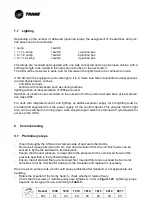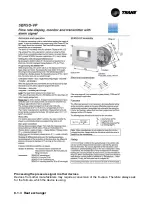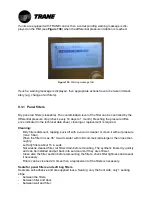
8.2.3 Refrigerant
Refrigerants used by TRANE are halogenated hydrocarbons, preferably R407C and R134a. These
are also known as safety refrigerants (safety group A1 according to EN378 part 1) in contrast to
flammable refrigerants such as Propane or toxic refrigerants such as Ammonia.
They are actually non-flammable under normal operating conditions and do not create explosive
mixtures with air, but are odourless. Only higher concentrations in the air can be noted by the ol-
factory sense.
Refrigerant vapours, which escape from leaking cylinders or refrigeration plants, will
be mixed unnoticedly with air and the risk of suffocation arises with concentration
through the displacement of the breathing essential oxygen. Humans are not able to
detect oxygen deficiency with their senses. As refrigerant vapour is heavier than air,
they concentrate at ground level and in lower-lying areas of the building. In order to
avoid the occurrence of higher concentrations, workplaces must always be ventilated
well.
Halogenated refrigerants can also have narcotic effect. In case of high refrigerant
concentration (e.g. tube leakage) the technical room the room must be evacuated
immediately. Enter only after adequate room ventilation.
If the room must be entered at high refrigerant concentrations, then a breathing apparatus that is
independent from the ambient air must be used. Furthermore such a breathing apparatus can only
be used by specially trained and medically suitable people.
8.2.4 Compressor lubricant
-
Compressor oil, a syntetic ester oil, is highly hygroscopic, so that the bound moisture in the oil
cannot be completely removed by the evacuation of refrigeration circuit.
-
Air entering in the system is to avoid strictly!
-
For R407C and R134a scroll compressors use Emkarate RL 32 3MAF oil.
8.3 Test run
After having done the preparatory work the unit can be started for the test run.
-
For testing the device and measuring the motor data and the volumetric flow rate, the device
must be fully connected to the operational duct system.
-
The unit doors must be closed, because by eliminating the system-side pressure drop meas-
urement errors will be the result.
Before starting the fan open the dampers! Fan may not run against closed dampers.








































